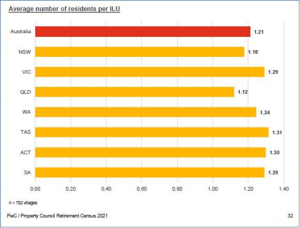Good nutrition is essential for healthy ageing – yet food often takes a backseat for retirement living, residential aged care and home care providers. How can you ensure your clients’ needs – and their family’s expectations – are met?
Around 50% of older Australians in the community are either at risk of malnourishment or malnourished, according to Dietitians Australia.
Extrapolate this figure across the number of people living in retirement villages and receiving aged care services and that is thousands of older Australians who are potentially facing malnutrition.
Malnutrition is associated with a weaker immune system, impaired wound healing, muscle wasting, longer stays in hospitals, greater care needs, and increased mortality.
But if your residents stay healthy, that means fewer complaints, less regulatory action and happier residents and families who are more likely to recommend your services to others.
So, how can retirement living, residential aged care and home care providers deliver optimum food and nutrition services to their clients?
RETIREMENT LIVING
Whether retirement village operators market themselves as ‘care providers’ or not, the reality is that families and residents themselves now expect that the village will help them to access to good-quality food and avoid the malnutrition which becomes more common as people age.
The average entry age in retirement villages is 75 years; the average age of retirement village residents is 81.
In addition, according to the 2021 Retirement Census data, the average number of residents per unit in retirement villages is 1.21 – so most residents live alone.

Simon Lockyer, co-founder and CEO of Brisbane-based home care provider Five Good Friends, says residents might have moved into a retirement village not being able to cook or, even if they can cook, don’t see the point in cooking for one.
Five Good Friends’ Move Nourish Connect program can help retirement village providers target nutrition among residents by assisting with:
- connecting residents to eligible funding pathways for home care packages and assisting with application navigation
- providing home care services to prepare or support the preparation of healthy food for the resident
- developing programs whereby their in-house nutritionist educates residents about the importance of good nutrition;
- connecting residents to appropriate healthy eating providers, such as Lite n’ Easy;
- helping residents offset their meal costs, including special cooking equipment, meals, and preparation costs, with their home care packages; and
- building communities around food, for example, by establishing cooking groups or times when residents come together, for example, for pizza night or a Sunday roast.
“That idea of the sharing of a meal. It inspires people to try new things, but also to just share eating and that joy of building a community around food,” Simon said.
With more retirement villages offering a continuum of care model, where residents receive home care services in the village or move into on-site residential aged care when their needs escalate, right up until the end of life, food is becoming an increasing consideration for operators.
In retirement villages, residents deal directly with Lite n’ Easy, often receiving funding for the meals through their Home Care Packages (HCPs) and ordering a range of meals they’ve selected for themselves.
AFFORDABILITY
Sarah Simeon, National Business Development Manager Home Care & NDIS at Lite n’ Easy, says retirement living, residential aged care and home care operators face three main challenges when it comes to delivering nutritious food for residents: affordability and scalability for in-house kitchens; consistency in creating great tasting and nutritious meals that residents want to eat; and meeting the growing demand for consumer choice and independence.
The Lite n’ Easy My Choice range of meals was developed off the back of nutritional research into the changing needs of older Australians and direct consumer feedback. Many older Lite n’ Easy customers were finding the standard dinner meal too large to finish in one sitting.
“Our My Choice range of meals are smaller, protein and energy-dense meals, specifically developed by Lite n’ Easy’s dietitians and chefs, to provide optimal nutrition for older Australians.
“But nutritious food is only good for you when you eat it, which means the food has to be enjoyable. As people age, they may also start to lose their sense of taste, so we have made sure our My Choice dinners, soups and desserts are packed full of flavour to maximise the enjoyment of eating and to ensure the meals are easier to finish,” Sarah said.
The development of Lite n’ Easy’s My Choice range was driven by consumer demand.
Sarah explains, “As our customer base aged, their needs started changing. We recognised that some of our older customers were not finishing a standard dinner meal in one sitting”. Since the release of our My Choice range, over 90% of these customers now reporting that they can consume the full My Choice meal in one sitting.
“Home care packages are assisting many older Australian to stay in their homes for longer. The ability to use a meal provider such as Lite n’ Easy within their package funding greatly assists.
“Nutritious, great-tasting food that is easily accessible is such a large part of being able to live independently at home,” Sarah said.
Lite n’ Easy has 235 meals to choose from their breakfast, lunch, dinner and snacks menu. The My Choice range includes more than 50 dinners, soups and desserts.
HOME CARE
To make meals more affordable, Lite n’ Easy looks across the whole business to find efficiencies, especially now with inflation so high.
“Though some of our prices have risen, we have managed to keep price rises below inflation without compromising on the quality or the nutritional standards or the flavour. We’ve also introduced new measures to ensure our customer service levels remain at the highest levels possible,” Sarah said.
“We have a dedicated fleet of drivers delivering to more than 95% of the population nationally. With an average driver tenure of 9 years, Lite n’ Easy delivery partners get to know their clients. This familiarity creates not only efficiencies but also a critical point of social connection for older people who might otherwise be quite isolated.
“Lite n’ Easy also has dedicated call centres in five states – so clients can ring and speak to someone.
“We add a little bit of joy to their week, whether it’s a meal or a conversation with one of our call centre consultants, or simply knowing that their regular driver will deliver their meals each week,” Sarah said.
Home care providers also host ‘food expos’ in retirement villages, with Lite n’ Easy presenting information to residents about nutrition and their range of meals.
CONSUMER CHOICE
After providing meals to residential aged care providers during the pandemic, Lite n’ Easy is now working with providers to help them meet consumers’ changing food preferences.
During the Aged Care Royal Commission, it was revealed that 68% of aged care residents are malnourished or at risk of malnourishment – leading to the $10 per day supplement to the Basic Daily Fee. Food is also a key component of the new Star Rating system.
Sarah said, “We’re talking to providers about how we can help within the kitchen environment to provide cost-effective meal solutions, particularly where labour costs eclipse the resident’s ingredient cost, making many services un-scalable.
“We currently produce 1.5 million meals per week out of five national kitchen locations, including a mix of fresh and frozen meal products. All of our meals are dietitian and chef-designed and we continue to innovate within our business to serve the aged care market in a greater capacity”.
Lite n’ Easy is beginning to provide “supplementary” meals to residential aged care providers, including meals to cater for specific food preferences as growing numbers of residents are asking for alternatives to the meals they are being served.
“It’s an opportunity we see in the residential aged care market, where if you’ve got someone who’s not happy with the meals that are being produced, they could have My Choice meals readily available through Lite n’ Easy, and also meet a guaranteed standard of taste, nutrition and food safety, which is obviously very important in that environment," Sarah said.
“GOOD OUTCOMES”
Sarah said, “As people age, eating the right food and exercising to protect muscle strength, means they can increase their mobility and have a much better quality of life. So, the more we can educate in that space, the better it is for all Australians.
“We’re focused on the food, but with advocacy for education, nutrition and wellness, coupled with physical exercise, everyone can get some really good outcomes










